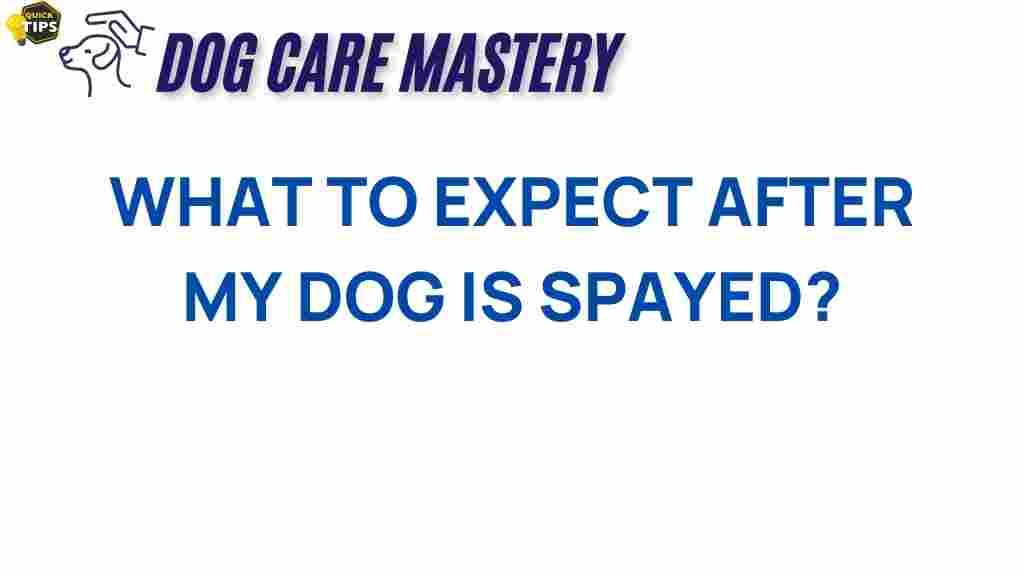What to Expect After Your Dog is Spayed: A Comprehensive Guide for Your Spayed Dog
Spaying your dog is one of the most responsible decisions you can make as a pet owner. Not only does it help control the pet population, but it can also bring numerous health benefits to your furry friend. However, the period following the surgery is crucial for your dog’s recovery. This comprehensive guide will walk you through what to expect after your dog is spayed, ensuring you are well-prepared to provide the best care for your spayed dog.
Understanding the Spaying Procedure
Before diving into post-operative care, it’s essential to understand what spaying entails. Spaying is a surgical procedure that removes the ovaries and usually the uterus of a female dog. This prevents her from going into heat and eliminates the possibility of pregnancy.
Immediate Post-Surgery Recovery
After the surgery, your spayed dog will likely experience some discomfort and grogginess as the anesthesia wears off. Here’s what you can expect:
- Monitoring Behavior: Your dog may seem lethargic and less interested in her surroundings. This is normal.
- Pain Management: The veterinarian will prescribe pain medication to help manage your dog’s discomfort. It’s important to follow the dosage carefully.
- Dietary Changes: Initially, you may need to restrict your dog’s food intake. Offer her small amounts of water and a light meal after a few hours.
Home Care for Your Spayed Dog
Once you bring your spayed dog home, follow these care tips to ensure a smooth recovery:
- Creating a Comfort Zone: Set up a quiet, comfortable space for your dog to rest. This should be away from other pets and household activities.
- Limit Activity: Keep your dog calm and prevent her from running, jumping, or playing for at least 10-14 days post-surgery. This is crucial for proper healing.
- Monitor the Incision Site: Check the surgical site daily for signs of infection, such as redness, swelling, or discharge. Contact your vet if you notice anything unusual.
Signs of Complications
While most spayed dogs recover without issues, it’s important to watch for signs of complications:
- Excessive swelling or redness at the incision site
- Persistent vomiting or diarrhea
- Loss of appetite that lasts more than 24 hours
- Severe lethargy or unresponsiveness
If you observe any of these signs, it’s crucial to contact your veterinarian immediately.
Managing Your Dog’s Behavior Post-Spay
After spaying, some behavioral changes may occur. Here’s how to manage them:
- Calm Environment: Keep the environment calm and minimize stress. Loud sounds or chaotic situations can increase anxiety.
- Routine: Maintaining a consistent routine can help your dog feel more secure during her recovery.
- Follow-Up Visits: Schedule a follow-up appointment with your vet to ensure your dog is healing properly and to remove any stitches if necessary.
Nutrition After Spaying
Proper nutrition is essential for your spayed dog’s recovery:
- High-Quality Food: Provide high-quality dog food that is appropriate for her age and size.
- Monitor Weight: Spaying can sometimes lead to weight gain, so monitor her food intake and adjust portions accordingly.
- Hydration: Ensure your dog has access to fresh water at all times.
Exercise and Activity Guidelines
Physical activity is important, but after spaying, it must be carefully managed:
- Short Leash Walks: After a few days, you can start taking your dog for short, leashed walks to prevent boredom.
- No Off-Leash Play: Avoid off-leash play or visits to dog parks until your veterinarian gives the all-clear.
- Gradual Increase: Gradually increase her activity level as she heals, always under the guidance of your vet.
Possible Long-Term Changes in Your Spayed Dog
Spaying can lead to several long-term changes in your dog:
- Health Benefits: Reduced risk of certain cancers, infections, and health issues related to the reproductive system.
- Behavioral Changes: Spaying may lead to a calmer demeanor, reduced aggression, and less roaming behavior.
- Weight Management Needs: Your spayed dog may require a change in diet and exercise to maintain a healthy weight.
Frequently Asked Questions About Spaying
Here are some common questions pet owners have after their dog is spayed:
- When can my dog resume normal activities? Typically, dogs can resume normal activities after about 10-14 days, but always follow your vet’s advice.
- Will my dog’s personality change? While some changes may occur, most dogs retain their personality. You may notice a calmer demeanor.
- Can I bathe my dog after she is spayed? It’s best to avoid bathing your dog for at least 10 days to prevent infection at the incision site.
Troubleshooting Common Issues
Sometimes, challenges may arise post-surgery:
- Excessive Licking of the Incision: If your dog is licking the incision, consider using an Elizabethan collar to prevent this.
- Appetite Changes: If your dog refuses to eat, try offering her favorite treats or warming her food slightly.
- Restlessness: Ensure your dog has plenty of mental stimulation and toys to keep her occupied during recovery.
Conclusion
Caring for your spayed dog after surgery is a vital part of ensuring her health and well-being. By monitoring her recovery, providing a calm environment, and following your veterinarian’s instructions, you can help your furry friend heal properly and enjoy a long, happy life. Remember, if you have any concerns during the recovery process, don’t hesitate to contact your veterinarian for guidance. For more resources on dog care, check out this helpful article on pet health.
For further information on spaying and its benefits, visit this external resource here.
This article is in the category Health and created by dogcaremastery Team
